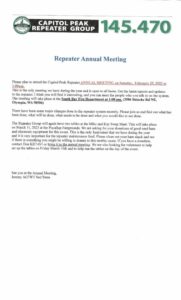Solar activity plunged this reporting week, although there was some excitement on February 17, 2023, when the solar flux was reported as a record breaking 343.1.
Because it was the noon reading, it is still reported by the National Oceanic and Atmospheric Administration (NOAA) as the solar flux, but this was a false reading when the Penticton detectors were overloaded by energy from a solar flare.
So, in this report, I have chosen the 1800 UTC flux value, which was 165.
The average daily sunspot number plunged from 182.4 to 107, while the average solar flux dropped from 196.4 to 162.4. If I had not changed the 343.1 to 165, the solar flux average would have been 187.9.
Six new sunspots emerged over the week, one on February 16, one each on February 18 and 19, and three more on February 20.
The solar flux prediction for the next month shows a peak value of 180 for March 7 – 13.
Predicted values are 150 on February 23; 148 on February 24 – 25; 146 on February 26 – 27; 142 on February 28; 140 on March 1; 145 on March 2 – 3; 150, 155, and 165 on March 4 – 6; 180 on March 7 – 13; 175 and 170 on March 14 – 15; 160 on March 16 – 17; 155, 160, 150, 140, and 135 on March 18 – 22; 125 on March 23 – 24; 130 on March 25, and 140 on March 26 – 28.
Predicted planetary A index is 8 on February 23 – 24; 10, 5, and 12 on February 25 – 27; 18, 16, and 8 on February 28 – March 2; 5 on March 3 – 4; 15, 18, 15, and 8 on March 5 – 8; 5 on March 9 – 14; 15 on March 15; 8 on March 16 – 17; 5 on March 18 – 20; 10 on March 21 – 23; 5 on March 24 – 25, and 8 on March 26 – 27.
Jon Jones, N0JK, wrote:
“There was a nice 6-meter F2 opening on February 16.
I logged [the] HC1MD/2 grid FI57 on 50 MHz FT8 at 1916 UTC. I found this opening by checking the DXMaps website. HC1MD/2 had a strong, steady signal. I operated from home using an attic dipole antenna. [I] also logged HC2FG.
Other area 6-meter operators such as WQ0P (EM19) and KF0M (EM17) also worked stations in Chile. The K index was 4, which I suspect may have helped.
On February 18, a number of North American stations worked Robert Felicite, 3B9FR, around 1600 UTC on 6-meter FT8.
(3B9FR is on Rodrigues Island in the Indian Ocean, off the southeast coast of South Africa)
Conditions were great [during] the ARRL [International] DX CW Contest on 10 meters. I operated [for] a couple of hours [on] Sunday morning [while] running 5 W and a quarter-wave whip fixed mobile. [I] worked [more than one] hundred stations
Europe, the Caribbean, South America, and Africa. Many of the Europeans were over S-9.”
Sunspot numbers for February 16 – 22 were 101, 86, 109, 112, 135, 106, and 100, with a mean of 107. The 10.7-centimeter flux was 163.2, 165, 167.2, 169, 159.8, 160.9, and 151.9, with a mean of 162.4. Estimated planetary A indices were 24, 6, 6, 7, 8, 17, and 6, with a mean of 10.6. The middle latitude A index was 21, 4, 5, 4, 6, 15, and 4, with a mean of 8.4.
A comprehensive K7RA Solar Update is posted Fridays on the ARRL website. For more information concerning radio propagation, visit the ARRL Technical Information Service, read “What the Numbers Mean…” and check out the Propagation Page of Carl Luetzelschwab, K9LA.
A propagation bulletin archive is available. For customizable propagation charts, visit the VOACAP Online for Ham Radio website.
Share your reports and observations.

